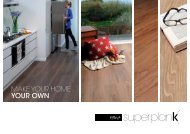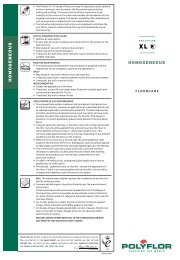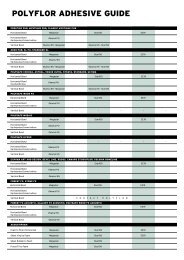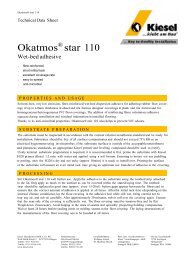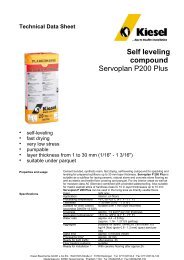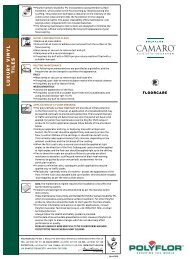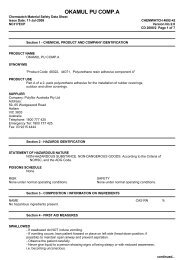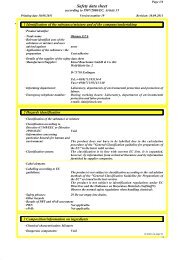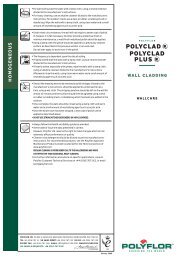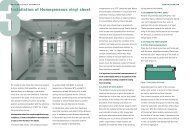Safety Solutions Brochure - Polyflor
Safety Solutions Brochure - Polyflor
Safety Solutions Brochure - Polyflor
Create successful ePaper yourself
Turn your PDF publications into a flip-book with our unique Google optimized e-Paper software.
F R E Q U E N T L Y A S K E D Q U E S T I O N S<br />
Q. Does <strong>Polyflor</strong> supply wall cladding and can this be<br />
joined to Polysafe material?<br />
A. Yes, <strong>Polyflor</strong> can supply the whole package. Our Polyclad PU<br />
and Polyclad Plus PU wall coverings can be supplied and used in<br />
conjunction with Polysafe vinyl floorcoverings and welded<br />
together at the seams to create an impermeable surface without<br />
dirt, water or bacteria ingress. Floor finishes from our <strong>Polyflor</strong><br />
Ejecta range can also be used to create the perfect watertight<br />
finish, for example a cove former to enable Polysafe material to<br />
be flexibly fitted from the floor up to the wall through site-formed<br />
coving. A complete floor to wall solution...<br />
Q. Can Polysafe be laid onto foam to create increased<br />
acoustic performance?<br />
A. Yes, increasingly in schools and social housing projects, the<br />
issues of underfoot safety and acoustic performance are<br />
becoming intertwined in an endeavour to comply with Part E of<br />
the UK Building Regulations (2003 Edition). The <strong>Polyflor</strong> solution<br />
to this is to combine safety flooring with use of our closed cell<br />
Acoustifoam product. This is a 2mm thick layer of sheet foam laid<br />
on the subfloor first, with Polysafe or alternative <strong>Polyflor</strong> smooth<br />
vinyls laid over the top of the Acoustifoam. This combination in no<br />
way impairs the performance of the safety flooring and will provide<br />
an impact sound reduction level of over 18dB in acoustic<br />
performance when tested to EN ISO 140-8. This exceeds the<br />
requirements set down in the UK Building Regulations.<br />
This acoustic performance can also be achieved on a safety floor by<br />
specifying Polysafe Wood FX Acoustic, complete with an integrated<br />
foam backed layer that is built into the product and gives an impact<br />
sound reduction level of 19dB and above.<br />
Q. What is the best way to clean your Polysafe<br />
safety flooring?<br />
A. All our Polysafe ranges require a straightforward<br />
maintenance regime. Firstly, sweep, mop sweep or dry vacuum<br />
the floor to remove loose dust, grit and debris. Next, apply a<br />
solution of neutral or alkaline cleanser to the floor diluted to the<br />
manufacturer’s instructions, with enough time given for the<br />
solution to react with the soiling. The floor should then be machine<br />
scrubbed using a 165 rpm rotary machine fitted with a rotary<br />
scrubbing brush, or if necessary, a scrubbing pad, followed by the<br />
slurry being picked up with a wet vacuum. For areas where no<br />
suitable scrubbing machine is available, a deck scrubber should<br />
be used in conjunction with a wet vacuum or mop and bucket<br />
system. Where a mop and bucket system is used, it would be<br />
pertinent to use a separate bucket to wring the mop out and hold<br />
the dirty water, thereby increasing the dirt removal. The floor<br />
should then be rinsed thoroughly with clean, warm water and<br />
picked up with a wet vacuum and left to dry thoroughly. It is<br />
important that those responsible for floor maintenance leave the<br />
floor to dry completely before pedestrians are allowed access. In<br />
areas where this is not possible, suitable barriers should be used<br />
to tell people that the floor is still wet and if possible advise them<br />
to make alternative bypass routes.<br />
For areas where there are instances of water-based spillages, an<br />
effective method of removing these contaminants can involve<br />
cleaning spills up immediately as they happen. This ‘clean as you’<br />
go policy avoids spreading contamination around the floor as<br />
spillages are taken care of immediately. This allows<br />
contamination to be controlled as these spot cleanings are<br />
carried out at times separate to the whole floor area being<br />
cleaned. For water spillages, users can undertake spot mopping<br />
or cleaning, using a paper towel or similar to remove small areas<br />
of contamination from the floor. For greasy and oily spills, a<br />
neutral detergent, diluted to the manufacturer’s instruction<br />
should be used to spot mop the contaminant. Stubborn black<br />
marks can be removed by using the centre disc of a scrubbing pad<br />
and a small amount of undiluted alkaline cleanser. The disc should<br />
be placed under the sole of the shoe and rubbed to give greater<br />
pressure to the surface.<br />
For SUPRATEC + products, all the traditional methods of<br />
maintenance such as scrubbing machines can be used. However, a<br />
clean microfibre mop can also be used to pick up the diluted<br />
solution of detergent once it has reacted to the soiling, using a<br />
continuous side-to-side motion. Once the mop head becomes<br />
loaded, it will start streaking the floor. At this stage, the dirty mop<br />
head should be replaced with a clean mop head. The cycle should<br />
then be repeated until the whole floor is completed.<br />
For POLYSAFE HYDRO, our profiled emboss product for<br />
continually wet and barefoot areas, the scrubbing pad on the<br />
rotary machine should be replaced with a rotary scrubbing brush,<br />
bristle brush or deck scrubber. Alternatively, a cylindrical type<br />
scrubbing machine should be used. All spot cleaning for this<br />
product should involve the use of a deck scrubber.<br />
The frequency for each type of cleaning operation is dependent<br />
upon the type and intensity of traffic. However, if cleaning<br />
procedures are carried out daily, it may be possible for the<br />
maintenance regime to be undertaken last thing at night, so the<br />
flooring is dry for the start of the next working shift.<br />
Full maintenance information for each Polysafe range and<br />
recommended maintenance products are available online at<br />
www.polyflor.com or via <strong>Polyflor</strong> Customer Technical Services.<br />
Q. Can I apply polish to your safety flooring?<br />
A. Categorically, any polish or floor maintainer should not be<br />
applied to any Polysafe flooring as this may impair the main<br />
performance attribute of the floor - its slip resistance. For further<br />
advice please contact our Customer Technical Services.<br />
Q. Can I use under-floor heating with Polysafe flooring?<br />
A. Yes, all Polysafe vinyl product ranges can be installed over<br />
underfloor heating, providing that the service operating<br />
temperature does not exceed 27°C (80° F) and the heating<br />
system is switched off during the installation period from 48<br />
hours prior to installation until 48 hours afterwards. The adhesive<br />
used should be capable of withstanding temperatures up to 27°C.<br />
Q. How dry does a subfloor need to be before Polysafe<br />
can be laid?<br />
A. Polysafe flooring should only be laid on subfloors where the<br />
moisture level does not exceed 75% RH in accordance with<br />
BS 8203 and which do not suffer from rising damp or hydrostatic<br />
pressure.<br />
The Hygrometer is the only method of test acceptable as detailed<br />
in BS 8203 and only readings taken over at least a 72 hour period<br />
should be considered to represent the moisture content of the<br />
subfloor. Subfloors with a relative humidity in excess of 75% will<br />
invariably cause failure of the bond between the substrate and<br />
floorcovering. <strong>Polyflor</strong> does not condone the practice of laying<br />
safety flooring direct to subfloors with moisture content readings<br />
above 75% and accepts no responsibility for non-performance of<br />
Polysafe products in such instances. For further advice on<br />
methods to implement when the moisture of a subfloor exceeds<br />
75%, please contact <strong>Polyflor</strong> Customer Technical Services.<br />
37



